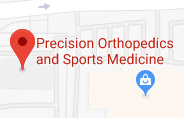Distal Radius Fracture
- Introduction
- Causes
- Symptoms
- Diagnosis
- Treatment
- Nonsurgical treatment
- Surgical treatment
- Open fractures
Introduction
The forearm consists of two bones, the radius and ulna. The radius is the larger of the two forearm bones, and the region towards the wrist is called the distal end. Fractures in this end are most common.
The distal radius can be broken in various ways, but generally occurs around 1 inch from the distal end of the wrist. The most commonly occurring distal radius fracture is the colles fracture, which leads to an upward tilting of the broken radius bone. Other types of distal radius fractures include:
- Intra-articular fracture: Fracture extending into the wrist joint
- Extra-articular fracture: Fracture not extending into the wrist joint
- Open fracture: Fractured bone, which breaks through the skin
- Comminuted fracture: Bone fractured into more than two pieces
Causes
Falling onto an outstretched arm is the most common way to fracture the distal radius. Other causes include:
- Minor falls with the presence of osteoporosis (fragile bones)
- Major trauma to the wrist during a vehicular accident
Symptoms
The symptoms occurring with distal radius fractures include bruising, swelling, immediate pain and tenderness, and limited mobility. The broken wrist may also appear deformed.
Diagnosis
Your doctor will diagnose distal radius fractures by ordering an X-ray of the wrist to detect broken or displaced bone. Your doctor can also view the number of pieces the bone is broken into from the X-ray images. Sometimes, a computer tomography (CT) scan may be required to get a detailed view of the fractured fragments.
Treatment
You can protect your wrist with a splint and apply an ice pack while keeping the wrist elevated until the doctor examines it. The choice of treatment will depend on your age, level of activity, nature of fracture and your surgeon’s preference.
Nonsurgical treatment
If the bone is aligned properly even after the fracture, a plaster cast may be enough to allow it to heal on its own. In case the broken bones are misaligned, realignment of the broken fragments may be required. For this, your doctor may perform closed reduction, which involves moving the broken bone pieces into place and straightening the bone without opening the skin. After alignment of bones, your doctor will place a splint or cast on your arm. The splint may be used initially for a few days till the swelling subsides, after which a cast may be added. The cast may be changed after a few weeks as it loosens with the reduction in swelling.
The healing process will be monitored with regular X-rays. After the cast is removed, the doctor may recommend physical therapy to help improve the function and motion of your injured wrist.
Surgical treatment
Surgical therapy is recommended for fractures that are completely displaced and cannot be corrected with a cast. Open reduction technique involves directly accessing and aligning of the broken bones through an incision. After alignment, the bones can be secured together in the correct position with the use of any of the following or a combination of these techniques:
- Cast
- Plate and screws
- Metal pins (titanium or stainless steel)
- External fixation (outside the skin stabilizing frame to hold the bones in its aligned position until it heals)
Open fractures: Surgery is recommended for all open fractures within a few hours after the wrist injury. The bone and exposed soft tissues are thoroughly cleaned, antibiotics are administered to prevent infections, and internal fixation methods are used to hold the broken bones in correct position. For badly damaged soft tissues, a temporary external fixator may be placed. The internal fixation screws or plates may be placed after several days in a separate procedure.
2120 N. MacArthur Blvd
Suite 100
Irving, TX 75061
 Ph: (972) 438 4636
Ph: (972) 438 4636
 Fax:
(972) 438 2077
Fax:
(972) 438 2077

 Make an Appointment Online
Make an Appointment Online

 Shoulder
Shoulder Elbow
Elbow Wrist
Wrist Hand
Hand Patient Education
Patient Education Testimonials
Testimonials Map
& Location
Map
& Location Patient Forms
Patient Forms






